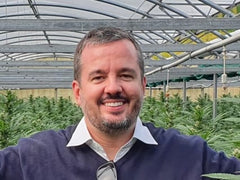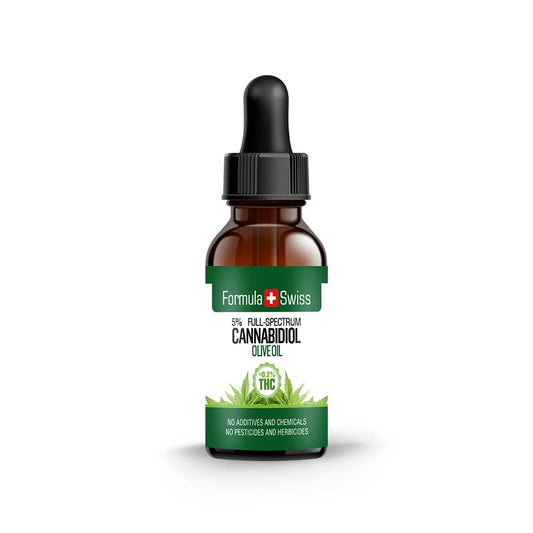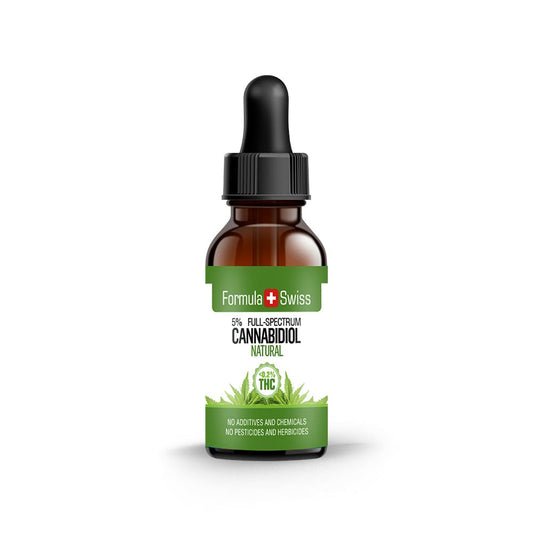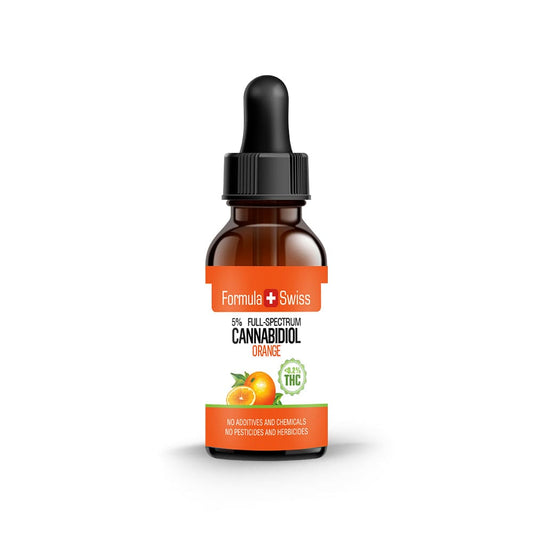CBDVA, or cannabidivarinic acid, is a non-psychoactive cannabinoid acid found in raw, unheated hemp. It acts as a biosynthetic precursor to CBDV (cannabidivarin) and is part of the varinic acid group of cannabinoids. Though present in only small amounts, it forms during the early stages of the plant’s development and contributes to the broader cannabinoid profile.
In my role at Formula Swiss, I’ve spent more than a decade working with hemp genetics, extraction, and formulation. Over that time, I’ve seen increasing interest in compounds like CBDVA—not just among researchers, but also among breeders and producers aiming to refine minor cannabinoid content.
A 2022 study in Frontiers in Pharmacology highlighted CBDVA’s role in cannabinoid biosynthesis and its presence in raw hemp material. Advances in selective breeding and extraction techniques have now made it easier to detect, isolate, and study CBDVA in more detail. This has placed it on the radar for those looking to understand the plant beyond just CBD and THC.
In this article, I’ll explain what CBDVA is, how it’s formed, and why it’s becoming more relevant in today’s cannabinoid research and development.
Prefer watching over reading? This video covers the key points from the article:
Save up to 30% when you order your CBD oil today
Key takeaways
- CBDVA is a non-psychoactive cannabinoid acid found primarily in raw, unheated hemp plants.
- It belongs to the varinic acid family and is a chemical precursor to CBDV (Cannabidivarin).
- CBDVA plays a role in the early stages of the cannabinoid biosynthesis process.
- Although lesser known, CBDVA is gaining interest among researchers and cultivators for its unique properties.
- Understanding CBDVA contributes to a broader comprehension of the cannabis plant’s complex chemical makeup.
This article is provided for informational purposes only and does not relate to any of the products available in our webshop. For more information, please see our full disclaimer.
Introduction to cannabidivarinic acid
Cannabidivarinic acid (CBDVA) is a non-psychoactive cannabinoid acid found in raw, unheated hemp. It acts as the chemical precursor to CBDV (cannabidivarin) and belongs to a subgroup of cannabinoids known as varinic acids, which differ from more common compounds like CBD and THC in structure and function.
Though research into CBDVA is still developing, recent advances in cannabinoid extraction and profiling have made it easier to identify and study. Its presence in the early stages of cannabinoid biosynthesis has made it a focus for breeders and scientists aiming to better understand the plant's full chemical range.
Ongoing research continues to explore how CBDVA contributes to the formation of other cannabinoids and how it might be used in future applications.
Understanding the structure of CBDVA
Looking at cannabinoids often starts with their structure. CBDVA stands out from more familiar compounds like CBD or THC because of its distinct molecular features. That difference is what makes it worth examining more closely.
The chemical composition of CBDVA
The chemical composition of CBDVA is my main focus. It has a three-carbon side chain, known as 'CBDVA-C3'. This sets it apart, affecting how it works in our bodies. This makes CBDVA research very interesting.

CBDVA is unique because of its molecular structure. Unlike CBD and THC, it has a three-carbon side chain. This molecular distinction calls for deeper study, possibly revealing new uses.
Studying CBDVA is captivating. It's about understanding its structure and comparing it to others. Each discovery brings us closer to the world of cannabinoid science.
Order and get up to 30% off your CBD oil
The extraction process of CBDVA
In cannabinoid research, extracting compounds like CBDVA requires precision. Based on my work in the field, isolating CBDVA and processing hemp isn’t straightforward—it depends on careful handling at every step to preserve quality.
It begins with selecting hemp strains that naturally produce higher levels of CBDVA. Once harvested, the plants are dried and cured to protect cannabinoid content. Extraction is typically carried out using advanced techniques such as supercritical CO₂, which offers an efficient and solvent-free way to isolate this delicate compound.

To get CBDVA alone, we use special chromatography. This method separates each compound, like CBDVA, without mixing them. It's a complex process that needs both knowledge and hands-on experience.
The final product of this careful process is used in many medicines. Thanks to new technology, we can make hemp compounds better and purer.
- Selection of hemp strains high in CBDVA.
- Employment of supercritical CO2 extraction for purity.
- Refinement through chromatography for precise isolation.
I know how important technology is. Every step is designed to improve the quality and use of CBDVA. It shows how vital it is for research into cannabinoids.
The significance of CBDVA in the hemp industry
The hemp industry is expanding rapidly, with growing interest in various plant-derived compounds. CBDVA, or cannabidivarinic acid, is one such compound that has attracted attention due to its distinct characteristics. Although still relatively obscure, it is being examined for its potential relevance in the evolving cannabinoid landscape.

Recognising CBDVA's position within the hemp sector contributes to the diversification of cannabinoid-based offerings. While compounds such as CBD and THC are more established, CBDVA is emerging as a subject of interest. This trend reflects the sector’s drive to explore lesser-known constituents of the hemp plant.
| Compound | Common sources | Research focus |
|---|---|---|
| CBDVA | Hemp | Being investigated for unique chemical properties |
| CBD | Hemp, cannabis | Extensively studied for its diverse applications |
| THC | Cannabis | Subject of research into various psychoactive effects |
The hemp industry is at a dynamic stage of development. Exploring compounds like CBDVA aligns with ongoing efforts to expand understanding and innovation within this space. This reflects a broader interest in the complexity and versatility of hemp-derived compounds.
Methods of isolating and concentrating CBDVA
Cannabinoid extraction methods are advancing quickly, and improving the isolation of CBDVA is an important focus. As interest in minor cannabinoids grows, so does the need for efficient techniques that can yield high-quality CBDVA oil.
Innovations in extraction technology are not only making the process more efficient but also resulting in purer, more consistent compounds suitable for research and formulation.
Technological advances in CBDVA extraction
New hemp processing tech is vital for better CBDVA isolation. Modern tools and methods help make extraction cleaner and more efficient. For example, supercritical CO2 extraction is a top tech. It makes sure the extraction is safe and clean, giving us pure CBDVA oil.

Quality control measures for CBDVA oil production
Keeping quality high is crucial for CBDVA oil. It involves testing at every step, from choosing raw materials to the final product. This makes sure the oil is safe and consistent.
These steps help keep the oil safe and meet high standards. It also makes the product reliable and trustworthy.
To understand quality control in CBDVA oil production, here's a quick overview.
| Parameter | Description | Importance |
|---|---|---|
| Purity | Measurement of the CBDVA concentration in the oil | Ensures product effectiveness and safety |
| Contaminant testing | Checks for the presence of heavy metals, pesticides, and solvents | Crucial for consumer safety and regulatory compliance |
| Consistency | Ensures that each batch of oil maintains a consistent level of CBDVA | Important for consumer trust and product reliability |
This focus on quality and new extraction methods shows a commitment to excellence. It ensures CBDVA oil is safe and of the highest standard.
Order CBD oil now and save as much as 30%
Beyond CBD and THC
The more time I’ve spent working with cannabinoids, the clearer it’s become that there’s far more to the plant than just CBD and THC. Compounds like CBDVA are finally starting to get noticed, showing just how chemically diverse cannabis really is.
CBDVA is a distinct part of the cannabis plant’s chemical profile. Looking into its role highlights why it’s important to study cannabinoids individually, not just the popular ones like CBD or THC. Each compound helps build a more complete picture of how the plant functions and what it may offer.
| Cannabinoid | Known for | Research focus |
|---|---|---|
| THC | Psychoactive effects | Studied for its effects on mood and behaviour |
| CBD | Non-psychoactive | Investigated in a range of scientific contexts |
| CBDVA | Lesser-known, non-psychoactive | Explored for distinct chemical characteristics |
Appreciating the complexity of cannabinoids is essential. Continued research into these compounds broadens our understanding of the cannabis plant and informs the development of diverse product applications within the regulated hemp sector.
Challenges and opportunities in CBDVA production
Producing CBDVA comes with both technical and practical challenges. Efficient extraction methods are still developing, and few hemp strains naturally produce high levels of this compound. On top of that, regulations and market acceptance differ widely across regions, making progress uneven.
Understanding CBDVA’s place in the cannabinoid market also means considering economic and logistical barriers. High production costs and limited supply can make it difficult for newer producers to compete, especially without targeted breeding or infrastructure.

Innovation is crucial in overcoming these challenges. Developing more efficient extraction methods can lower costs and increase yields. This could make CBDVA products more affordable and appealing to more people, boosting the hemp industry and CBDVA market.
Overcoming obstacles in CBDVA extraction
Technology advancements could solve many CBDVA extraction problems. Improving equipment efficiency and investing in research for better cultivation practices are key. These steps can help reduce the difficulties in extracting cannabinoids.
Economic aspects of CBDVA market development
| Aspect | Impact | Potential solutions |
|---|---|---|
| Production costs | High costs discourage scaling production | Optimisation of extraction processes |
| Market demand | Variable, often limited by public awareness | Increased marketing and educational efforts |
Looking into these economic aspects is vital for those in the CBDVA sector. With the right strategies, the current challenges can turn into opportunities. This can lead to significant growth in the market.
What’s next for CBDVA?
Looking ahead, the future of CBDVA holds significant potential. Ongoing research and emerging technologies are expected to bring meaningful developments. As these efforts progress, we can observe how scientific exploration is shaping the evolution of the hemp industry.
With CBDVA positioned at the forefront of cannabinoid research, it stands on the brink of further discovery. Continued study and innovative applications are likely to expand our understanding and highlight new possibilities for its use in various fields.
The potential of CBDVA extends beyond its current applications. It may influence how industries innovate and adapt. As we’ve seen, CBDVA could inspire the development of new hemp-derived products and processes.

The future direction of the hemp sector will likely be influenced by advancements in CBDVA research. This expanding body of knowledge could encourage wider integration and stimulate innovation across multiple areas.
When considering CBDVA's future, its role appears increasingly significant. It is poised to redefine how we approach both the science and commercial potential of hemp-based developments.
Personal perspective
Over the years, I’ve worked across nearly every part of the cannabis space, growing, extracting, researching, and formulating. That kind of hands-on experience changes the way you see the plant.
You start to realise just how complex it really is, especially when you dive into the minor cannabinoids like CBDVA. It’s not one of the big names, but it’s an important part of the plant’s story, and it’s finally starting to get the attention it deserves from those of us who work with hemp up close.
What keeps me so interested in compounds like CBDVA isn’t hype—it’s curiosity. These lesser-known cannabinoids help us better understand how the plant functions and evolves.
Each one adds a layer to the bigger picture, and for me, that’s what makes this field so compelling. It’s about uncovering the details that help us see the full scope of what cannabis really is.
Don’t miss out—save up to 30% when you purchase CBD oil today
Frequently asked questions
What exactly is CBDVA?
CBDVA, or cannabidivarinic acid, is a compound found in the hemp plant. It is structurally related to CBD but differs in certain ways, making it a subject of interest in scientific and industrial contexts.
How does the chemical structure of CBDVA differ from other cannabinoids?
CBDVA features a shorter side chain compared to many other cannabinoids, such as CBD and THC. This structural difference contributes to its distinct chemical behaviour.
Can you explain the significance of CBDVA in the hemp industry?
CBDVA holds significance in the hemp industry due to its unique attributes. Its distinct profile may contribute to a broader range of hemp-based product developments.
What are the potential research areas for CBDVA?
CBDVA’s unusual structure opens avenues for ongoing scientific inquiry. Researchers are interested in its interactions and roles within the broader spectrum of cannabinoids.
How is CBDVA extracted?
CBDVA is extracted using specialised techniques designed to preserve its molecular integrity. These methods enable effective separation from other plant constituents.
What innovative studies are being conducted on CBDVA?
Initial studies on CBDVA are focused on understanding its unique properties. These investigations are part of broader efforts to expand knowledge of minor cannabinoids.
What role does technology play in CBDVA extraction?
Technology plays a crucial role in the efficient extraction of CBDVA. Advanced equipment and methods are employed to obtain high-purity forms of this compound.
Why is quality control important in CBDVA oil production?
Quality control is essential in the production of CBDVA oil. It ensures that the final product adheres to regulatory and manufacturing standards, maintaining consistency and reliability.
What are the main challenges faced during CBDVA extraction?
CBDVA is typically present in low concentrations within hemp, making it difficult to isolate. Developing more refined extraction techniques is necessary to address this challenge.
How might the CBDVA market evolve economically?
The economic potential of the CBDVA market may expand with increased awareness. Market growth will be influenced by factors such as production costs, demand, and technological innovation.
What does the future hold for research on CBDVA?
Research on CBDVA is expected to progress as interest in minor cannabinoids continues to rise. Advances in analytical tools and methodologies will likely enhance understanding of its properties.
What is CBDA (Cannabidiolic Acid)?






